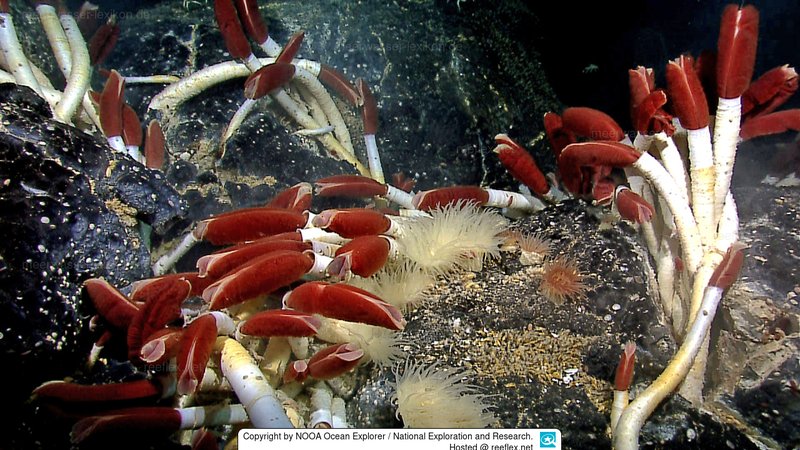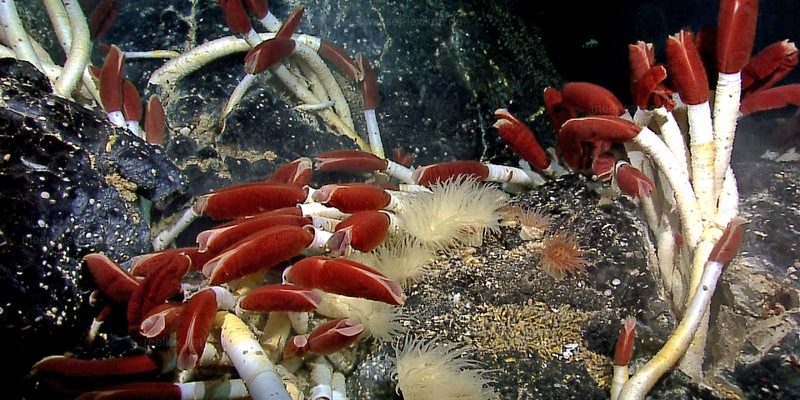
But it’s not just Riftia pachyptila that calls these vents home. There are other worm species sharing the same habitat, each with its own quirks and adaptations. Understanding how Riftia pachyptila compares to these similar species can shed light on the rich tapestry of life down there and how these creatures have evolved to thrive in such a harsh environment. Let’s dive in and explore!
What is Riftia Pachyptila?
Riftia pachyptila, commonly known as the giant tube worm, is an extraordinary creature. Found primarily around hydrothermal vents in the Pacific Ocean, these worms can grow up to 3 meters (about 10 feet) long! They live in protective tubes made of chitin, which helps them withstand the harsh conditions of their environment.
What’s particularly impressive about Riftia pachyptila is its symbiotic relationship with bacteria. You see, they don’t have a traditional digestive system. Instead, they rely on bacteria that live in their tissues to convert the chemicals from the vent water into energy. It’s like having a personal chef that uses the ingredients around them to whip up something incredible. This fascinating relationship is a perfect example of how life can adapt and thrive in extreme conditions.
Interestingly, these worms are bright red or pink, primarily because of the hemoglobin in their blood, which carries oxygen. You might think, “Why so colorful in the deep, dark sea?” Well, their color is actually a sign of their efficiency in oxygen transport and a helpful factor in their survival.
Similar Worm Species in Hydrothermal Vents
Riftia pachyptila isn’t the only worm hanging out near hydrothermal vents. You might be surprised to learn that there are several other species that share this niche, each with its own unique adaptations. This diversity gives us insight into how life can thrive under extreme circumstances.
One of the most notable similar species is the Osedax worm, which is known for its ability to consume the bones of dead marine animals. Rather than relying on the bacteria, Osedax has an entirely different approach, breaking down complex materials for nutrients. Imagine you’re at a buffet, and instead of the usual dishes, you find an entire table of skeletons—that’s how these worms feast!
Another counterpart is the Siboglinidae family, which includes various tube worms that also inhabit these vent systems. These worms may not grow as large as Riftia, but they, too, have fascinating adaptations that allow them to survive in similar environments. They have been found at different depths and conditions, showcasing a variety of survival strategies.
How They Adapt to Their Environment
Survival in the hydrothermal vent environment is a true test of adaptation. Each species, including Riftia pachyptila, has developed unique features that help them thrive. For Riftia, it’s all about that partnership with bacteria. The bacteria convert chemicals like hydrogen sulfide from the vent water into energy, making the worm a crucial player in the food chain.
Osedax, on the other hand, uses a completely different tactic. These worms have specialized enzymes that allow them to break down organic material found in bones. It’s kind of like being able to turn old, discarded things into a delicious meal; they make the most out of what’s around them, proving adaptability can take on many forms.
Another adaptation is their protection. Riftia pachyptila’s tube is not only a shelter but also a way to filter out debris and protect against predators. Similarly, the smaller tube worms have developed sturdy structures that allow them to anchor themselves in strong currents while also nurturing the symbiotic bacteria necessary for their survival.
The Role of Symbiosis in Their Ecosystem
Symbiosis is a critical theme in the relationships these worms have within their ecosystem. Riftia pachyptila relies heavily on its symbiotic bacteria, but it’s not alone. Many species of tube worms, including those in the Siboglinidae family, also have similar relationships.
These symbiotic bacteria live inside the worms and help them convert vent chemicals into usable energy. Here’s the kicker: without these bacteria, the worms wouldn’t survive. This partnership underscores how interconnected life is in these extreme environments. It’s a classic example of “you help me, and I’ll help you,” where both parties benefit significantly from the relationship.
This relationship extends to the entire ecosystem around hydrothermal vents, which is a bustling community supported by these tiny life forms. From the tiniest bacteria to the larger predators that feed on them, you can see how each species plays a part in balancing life in these unique habitats.
Comparing Feeding Mechanisms
Feeding mechanisms can vary widely among these worm species, and it’s fascinating to see how they tackle the challenge of getting nutrients. Riftia pachyptila relies solely on its symbiotic bacteria, as mentioned earlier. They harvest energy from the chemicals present in the vent fluids, which is a pretty unique approach compared to others in the area.
In contrast, Osedax worms have a different game plan altogether. Using a specialized method, they can digest tough organic material, like bones, making them quite the scavengers. This ability to feed on materials that others can’t touch gives them a significant advantage, especially in an ecosystem where carcasses from larger animals are a valuable source of nutrients.
Siboglinidae members also have a distinct mechanism that often aligns with the behaviors of Riftia. While they may not actively seek food like Osedax, they’ve adapted to extract nutrients from their environment effectively. It highlights the diversity of feeding strategies among these species, allowing them to coexist in a highly competitive space.
What We Can Learn from These Worms
Studying Riftia pachyptila and its similar counterparts opens a window into understanding how life can thrive under extreme conditions. It challenges our perception of life and survival, showcasing that not all organisms need sunlight or typical food sources to thrive.
These worms also provide valuable insights into potential discoveries for human applications. For instance, the unique properties of the bacteria that thrive in their bodies could lead to advances in biotechnology or medicine. You never know; studying these tiny creatures could inspire innovations that benefit us on the surface.
Plus, understanding these ecosystems helps us appreciate the delicate balance of life in the deep sea. It reminds us that even the most remote corners of our planet are filled with life, each playing its part in maintaining ecological harmony.
Conservation and Future Research
As we continue to learn about Riftia pachyptila and its fellow worms, it’s crucial to consider the impact of human activity on these ecosystems. Hydrothermal vents are susceptible to disturbance from deep-sea mining and other forms of exploration. Protecting these environments is essential not just for the worms, but for the entire ecosystem they support.
Future research should focus on understanding how these ecosystems respond to changes and what can be done to safeguard them. Improved monitoring and conservation efforts are vital to ensure that we don’t lose these incredible creatures and the knowledge they hold.
In summary, the deep-sea worms, especially Riftia pachyptila and its companions, illustrate the remarkable adaptability of life. By protecting their habitats, we’re also preserving a piece of our planet’s history and biodiversity for generations to come.
In essence, exploring the comparisons between Riftia pachyptila and other similar worm species paints a vibrant picture of life at hydrothermal vents. It’s a tapestry woven with survival, symbiosis, and endless curiosity—a reminder of how much there is still to discover about our world’s hidden depths.

